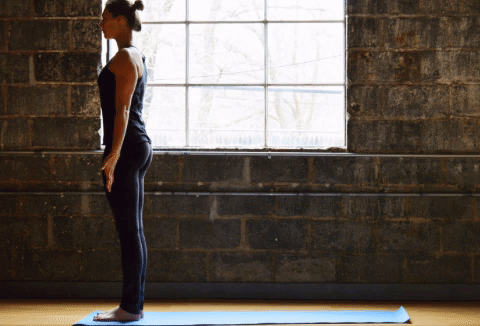August | Breathwork to Soothe + Calm Your Nerves

Photo via Pure Green Magazine
Deep breathing is my favorite. I’m not always very good at it, which is surprising, I know, but I think that’s why I love it so much and why I teach it in my classes so often. Like many of you, I struggle with panic and anxiety that at times feels hard to manage. When I feel overwhelmed or am just generally freaking out, my breath is always the first to go. Here’s the good part, our breath is the most effective tool we have to manage said anxiety. And that means anxiety of any kind, like the irrational anxiety of chair pose (it always ends, guys) the anxiety of going upside down, anxiety of sitting still in a quiet yoga class, of not checking your email—you get the idea.
Although we humans are a species prone to doubt, worry and futurize incessantly (thanks amygdala!) we’re also capable of healing these harmful patterns in a simple and intuitive way: our breath. The beauty and depth of this mind-body alchemy is so profound that whenever I teach it in class I’m always amazed by the shift of energy and focus in my students. Even if your anxiety is a genetic condition, like mine, there’s research that shows practicing breathwork can actually alter your DNA for the better. M.D.s and pioneers of the subject, Richard P. Brown and Patricia L. Gerbarg, wrote about this in the Huffington Post, saying, “One such study found that over time mind-body practices that elicited a relaxation response changed the expression of more than 1,000 genes, leading to altered metabolism, reduced production of destructive free radicals, and improved response to oxidative stress”. After reading this, I wondered if all medical experts abbreviate their middle names to sound extra profesh and if I should start doing the same (Katherine M. Oakes, Yoga Instructor) and if teaching breathwork could truly make an impact in our lives and those to come.
Deep thoughts. Important questions.
Anyway, I wanted to share a specific form of breathwork that I teach in yoga classes that works wonders both on and off the mat. It’s called Alternate-Nostril Breathing and I like to slide this puppy in after we’ve done a particularly demanding posture, like handstand or any other inversion that typically leaves people feeling short of breath and maybe even a little, er, aggravated. The psychosomatic effects of this technique range far and wide by helping to stimulate the Parasympathetic Nervous System and bring an equal flow of oxygen to both sides of your brain. Students will approach me after class and say something like, “OMG WHAT WAS THAT?!” or “that breathing thing we did was sooo relaxing”. Normally, I’d chalk it up to me being a fabulous yoga teacher—namaste—but for this, I can’t take credit. So, find a quiet moment to sit comfortably and give it a try. At first, you might be surprised at this dramatic shift but don’t be because as we always remind people at Yoga Mechanics: You work.
Alternate-Nostril Breathing
Take a comfortable seat with your back against the wall
Cover your left nostril with one finger (ring finger works well) and inhale in for a count of six
Pinch both nostrils and hold for three seconds
Cover your right nostril and exhale out for six seconds
Pinch both nostrils at the bottom of your breath and hold for three seconds
Repeat this fives times and practice extending the length of your inhales, exhales and holds (inhale for eight, hold for five, exhale for eight, etc.)
When you have finished, sit with your eyes closed and take at least three full rounds of breath, breathing as you normally and notice the difference in your mind, body and breath



















